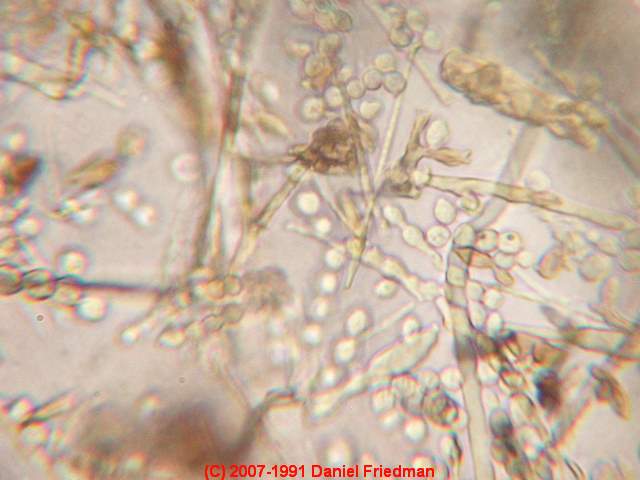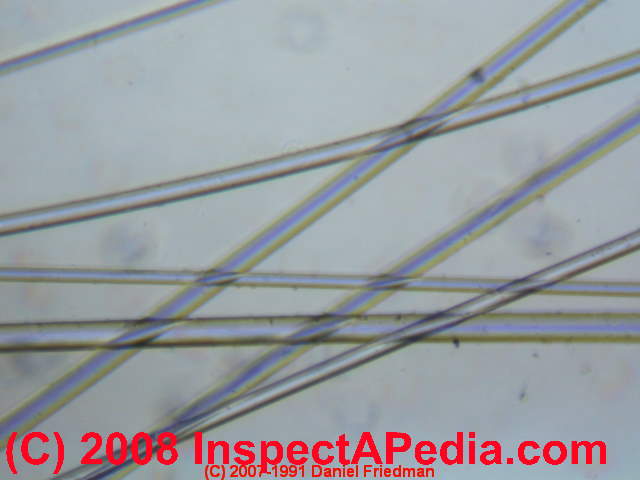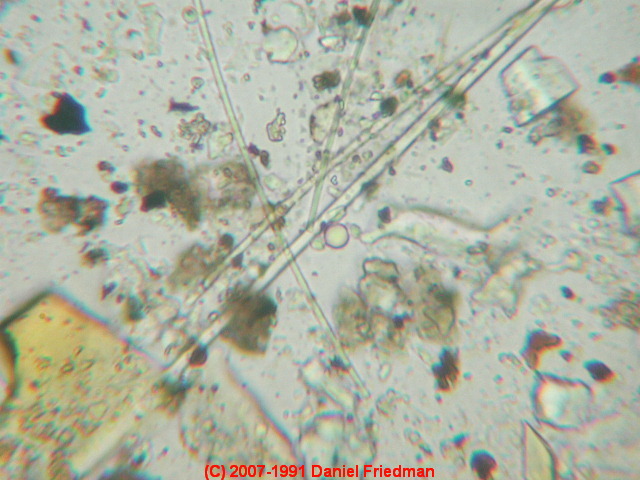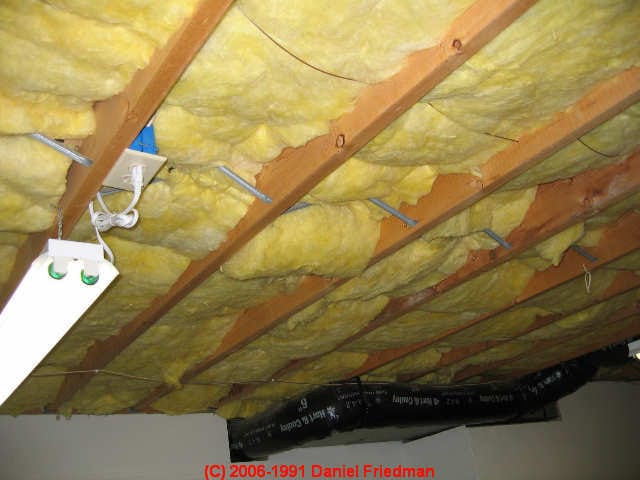 Mold in Fiberglass in Insulation that Looks Clean
Mold in Fiberglass in Insulation that Looks Clean
Fiberglass insulation can be mold-contaminated
- POST a QUESTION or COMMENT about mold contamination in fiberglass insulation that looks "clean" - where can the mold trouble come from? How is it detected? What should be done about moldy insulation? Are all insulation materials equally prone to hosting mold growth?
Inspect building insulation for mold contamination:
Can clean-looking insulation be moldy? This document provides information about the occurrence of problematic toxic or allergenic mold growth in fiberglass insulation that appears, on visual inspection, to be clean in residential and light-commercial buildings.
A 720x micro-photograph provided in this article shows active fungal growth along the surface of a fiberglass insulation fiber collected the suspended ceiling of a building suffering wet conditions and moldy in-slab HVAC ducts.
Mold is often found in basement fiberglass insulation, crawl space fiberglass insulation, fiberglass wall insulation, heating or cooling duct fiberglass insulation, and attic or roof insulation in buildings which have either been wet or have been exposed to high levels of mold from other sources.
InspectAPedia tolerates no conflicts of interest. We have no relationship with advertisers, products, or services discussed at this website.
- Daniel Friedman, Publisher/Editor/Author - See WHO ARE WE?
Moldy building or duct insulation may look clean on visual inspection
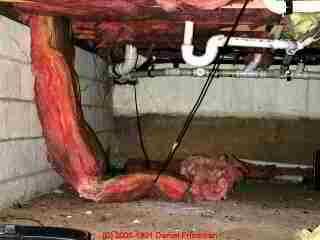
The fiberglass insulation falling into a crawl space at the photo above is obviously suspect for having been wet and possibly contaminated by rodents, insects, or toxic or allergenic mold.
But what about the nice new clean looking fiberglass insulation in the above photo?
That clean-looking fiberglass insulation was located over a clean-looking basement of a home less than ten years old.
But a closer inspection of the home, its exterior, and its basement (as well as attic) found several clues suggesting that during one or more prior springs the basement had been quite wet.
Check our our Mold-Contaminated building insulation photo below.
Mold-Contaminated building insulation:
But testing the clean looking yellow fiberglass in the photo show n earlier on this page disclosed the remarkably mold contamination shown in our photograph at left.
Special vacuum and agitation methods are needed to sample and test this material and special care is needed in choosing the sample or test location when looking for mold in fiberglass or other building insulation.
What can be tricky in investigations of mold contamination in building insulation is that severely mold-contaminated fiberglass insulation may look pretty clean to the naked eye (photo below.
Yet when we examined samples taken from this building insulation under the microscope we found Aspergillus/Penicillium spores in spore chains - telling us that there was a nearby and significant source of mold that had put a very high concentration of these harmful mold spores in the insulation itself (photo below).
Because Pen/Asp spores are "born" (produced by the conidiopore) in long spore chains which are quite fragile, these chains quickly break apart into individual spores when moving through air. So when we find these spores still attached in spore chains we know that a significant mold contamination source is close by.
Our next fiberglass insulation photo below shows clean looking insulation; in fact this is one of our baseline samples of clean fiberglass insulation fragments (taken from a sample of new fiberglass building insulation).
In a significant contrast, the photo below shows dirty looking insulation from an older building.
This photo of a sample collected from fiberglass insulation in an older building exposed to moisture and leaks shows a high level of particulate debris, almost certainly including organic debris such as skin cells, animal hair (FIBER & HAIR IDENTIFICATION), and insect fragments which can form a base for mold growth.
But we didn't detect problematic mold in either of these cases. So insulation may be dirty, contaminated with allergens, insect fecals, insect fragments, etc. without being moldy. You won't know for sure what's in older building insulation without examining it.
Of course a high level of insect fragments, mite fecals, or rodent fecal and urine-contaminants in any building insulation can result in indoor air quality complaints if air and dust move from that particle reservoir into the living area.
...
Reader Comments, Questions & Answers About The Article Above
Below you will find questions and answers previously posted on this page at its page bottom reader comment box.
Reader Q&A - also see RECOMMENDED ARTICLES & FAQs
Question: can exposed fiberglass insulation be an indoor air quality issue or hazard
My family and I purchased a home in August 2013. During the home inspection mold was identified on the basement wall in the utility room as well as in the HVAC system.
A specialist came in and treated the areas prior to us moving in.
We recently had our air ducts cleaned and again mold was in the HVAC system in the utility room. The utility room does not have a drop down ceiling, it only has exposed fiberglass insulation.
Since we moved my children and I have experienced itchy red bumps, fungus on various parts of the body (hand & foot) and the kids are complaining about it feeling like insects are crawling all over them. Our house was built in 1992 and there is no knowledge of original owner having any issue.
Our house is professionally cleaned 3x a month and we maintain a clean house due to having small children. Could the effects from the exposed insulation be the issue? June 3, 2014 Jason
Reply:
Jason
Certainly fiberglass dust could cause the complaints you cite and irritating levels of fiberglass fragments might be present IF fiberglass insulation has been damaged, cut, stepped on, mechanically disturbed and is located in the living area.
Normal housecleaning vacuuming can increase airborne dust.
Try stapling up Tyvek or equivalent to cover the insulation, then clean by damp wipe then HEPA vacuuming the surfaces in and near your utility room or elsewhere in the home as your on-site environmental inspector can advise.
See details
at MOLD CLEANUP GUIDE to GET RID OF MOLD
Followup from Jason:
Thank you for your quick response...how do I safely enter/exit my house? I am worried for my children's health, if mold was present in HVAC(located in utility room) and mold in other spots in the utility room wouldn't there be a good chance its in the insulation as well? And should it be removed immediately?
Reply:
Normal cleaning including damp mopping and HEPA Vacuuming along with the suggestions I made earlier should help.
...
Continue reading at WHY DOES MOLD GROW in INSULATION? or select a topic from the closely-related articles below, or see the complete ARTICLE INDEX.
Or see these
Recommended Articles
- TEST CHOICES for MOLD in FIBERGLASS
- MOLD ACTION GUIDE - WHAT TO DO ABOUT MOLD
- MOLD CLEANUP GUIDE to GET RID OF MOLD
- MOLD / ENVIRONMENTAL EXPERT, HIRE ?
Suggested citation for this web page
INSPECTION of INSULATION for MOLD at InspectApedia.com - online encyclopedia of building & environmental inspection, testing, diagnosis, repair, & problem prevention advice.
Or see this
INDEX to RELATED ARTICLES: ARTICLE INDEX to MOLD CONTAMINATION & REMEDIATION
Or use the SEARCH BOX found below to Ask a Question or Search InspectApedia
Ask a Question or Search InspectApedia
Try the search box just below, or if you prefer, post a question or comment in the Comments box below and we will respond promptly.
Search the InspectApedia website
Note: appearance of your Comment below may be delayed: if your comment contains an image, photograph, web link, or text that looks to the software as if it might be a web link, your posting will appear after it has been approved by a moderator. Apologies for the delay.
Only one image can be added per comment but you can post as many comments, and therefore images, as you like.
You will not receive a notification when a response to your question has been posted.
Please bookmark this page to make it easy for you to check back for our response.
IF above you see "Comment Form is loading comments..." then COMMENT BOX - countable.ca / bawkbox.com IS NOT WORKING.
In any case you are welcome to send an email directly to us at InspectApedia.com at editor@inspectApedia.com
We'll reply to you directly. Please help us help you by noting, in your email, the URL of the InspectApedia page where you wanted to comment.
Citations & References
In addition to any citations in the article above, a full list is available on request.
- Adkins and Adkins Dictionary of Roman Religion discusses Robigus, the Roman god of crop protection and the legendary progenitor of wheat rust fungus.
- [4] Kansas State University, department of plant pathology, extension plant pathology web page on wheat rust fungus: see http://www.oznet.ksu.edu/path-ext/factSheets/Wheat/Wheat%20Leaf%20Rust.asp
- [5] Ahearn, D.G., S A Crow, R B Simmons, D L Price, J A Noble, S K Mishra and D L Pierson, "Fungal colonization of fiberglass insulation in the air distribution system of a multi-story office building: VOC production and possible relationship to a sick building syndrome", Journal of Industrial Microbiology & Biotechnology, Volume 16, Number 5 (1996), 280-285, DOI: 10.1007/BF01570035. Abstract:
Complaints characteristic of those for sick building syndrome prompted mycological investigations of a modern multi-story office building on the Gulf coast in the Southeastern United States (Houston-Galveston area). The air handling units and fiberglass duct liner of the heating, ventilating and air conditioning system of the building, without a history of catastrophic or chronic water damage, demonstrated extensive colonization with Penicillium spp and Cladosporium herbarum. Although dense fungal growth was observed on surfaces within the heating-cooling system, most air samples yielded fewer than 200 CFU m–3. Several volatile compounds found in the building air were released also from colonized fiberglass. Removal of colonized insulation from the floor receiving the majority of complaints of mouldy air and continuous operation of the units supplying this floor resulted in a reduction in the number of complaints. - [6] Ahearn, D.G., S.A. Crow, R.B. Simmons, D.L. Price, S.K. Mishra and D.L. Pierson, "Fungal Colonization of Air Filters and Insulation in a Multi-Story Office Building: Production of Volatile Organics", Current Microbiology Volume 35, Number 5 (1997), 305-308, DOI: 10.1007/s002849900259, Abstract:
Secondary air filters in the air-handling units on four floors of a multi-story office building with a history of fungal colonization of insulation within the air distribution system were examined for the presence of growing fungi and production of volatile organic compounds. Fungal mycelium and conidia of Cladosporium and Penicillium spp. were observed on insulation from all floors and both sides of the air filters from one floor. Lower concentrations of volatile organics were released from air filter medium colonized with fungi as compared with noncolonized filter medium. However, the volatiles from the colonized filter medium included fungal metabolites such as acetone and a carbonyl sulfide-like compound that were not released from noncolonized filter medium. The growth of fungi in air distribution systems may affect the content of volatile organics in indoor air. - [7] Price,D. L., R. B. Simmons, I. M. Ezeonu, S. A. Crow and D. G. Ahearn, "Colonization of fiberglass insulation used in heating, ventilation and air conditioning systems", Journal of Industrial Microbiology & Biotechnology Volume 13, Number 3 (1994), 154-158, DOI: 10.1007/BF01584000, Abstract: The number of fungal species colonizing thermal and acoustic fiberglass insulations used in heating, ventilation, and air conditioning (HVAC) systems was fewer than that obtained from initial direct culture of these insulations. The colonization, determined by the microscopic observation of conidiophores with conidia, was primarily of acrylic-latex-facing material, but eventually the fungi permeated the fiberglass matrix. Isolates of Aspergillus versicolor were most often obtained from non-challenged insulation, whereasAcremonium obclavatum appeared to be the primary colonizing fungus in high-humidity (>90%) challenge chambers. At a lower humidity (about 70%) Aspergillus flavus was one of the more prominent fungi. Not all duct liner samples were equally susceptible to colonization and duct board appeared relatively resistant to colonization.
- [8] Simmons, R. B. and S. A. Crow, "Fungal colonization of air filters for use in heating, ventilating, and air conditioning (HVAC) systems", Journal of Industrial Microbiology & Biotechnology Volume 14, Number 1 (1995), 41-45, DOI: 10.1007/BF01570065, Abstract:
New and used cellulosic air filters for HVAC systems including those treated with antimicrobials were suspended in vessels with a range of relative humidities (55–99%) and containing non-sterile potting soil which stimulates fungal growth. Most filters yielded fungi prior to suspension in the chambers but only two of 14 nontreated filters demonstrated fungal colonization following use in HVAC systems. Filters treated with antimicrobials, particularly a phosphated amine complex, demonstrated markedly less fungal colonization than nontreated filters. In comparison with nontreated cellulosic filters, fungal colonization of antimicrobial-treated cellulosic filters was selective and delayed. - [9] Ifeoma M. Ezeonu, Daniel L. Price, Sidney A. Crow and Donald G. Ahearn, "Effects of extracts of fiberglass insulations on the growth of Aspergillus fumigatus and A. versicolor", Mycopathologia Volume 132, Number 2 (1995), 65-69, DOI: 10.1007/BF01103777
, Abstract:
Water extracts of thermal and acoustic fiberglass insulations used in the duct work of heating, ventilation and air conditioning (HVAC) systems supported germination of conidia and growth of Aspergillus versicolor (Vuillemin) Tiraboschi 1908–9 and Aspergillus fumigatus Fresenius 1863. Urea, formaldehyde and unidentified organics were detected in the extracts. Formaldehyde in concentrations similar to those found in the extracts restricted the growth of both species in enriched media. A. versicolor, the more common species associated with fiberglass insulations, was more resistant to formaldehyde than A. fumigatus. - Fiberglass carcinogenicity: "Glass Wool Fibers Expert Panel Report, Part B - Recommendation for Listing Status for Glass Wool Fibers and Scientific Justification for the Recommendation", The Report on Carcinogens (RoC) expert panel for glass wool fibers exposures met at the Sheraton Chapel Hill Hotel, Chapel Hill, North Carolina on June 9-10, 2009, to peer review the draft background document on glass wool fibers exposures and make a recommendation for listing status in the 12th Edition of the RoC. The National Institute of Environmental Health Sciences is one of the National Institutes of Health within the U.S. Department of Health and Human Services. The National Toxicology Program is headquartered on the NIEHS campus in Research Triangle Park, NC. The National Institute of Environmental Health Sciences is one of the National Institutes of Health within the U.S. Department of Health and Human Services. The National Toxicology Program is headquartered on the NIEHS campus in Research Triangle Park, NC.
Following a discussion of the body of knowledge, the expert panel reviewed the RoC listing criteria and made its recommendation. The expert panel recommended by a vote of 8 yes/0 no that glass wool fibers, with the exception of special fibers of concern (characterized physically below), should not be classified either as known to be a human carcinogen or reasonably anticipated to be a human carcinogen. The expert panel also recommended by a vote of 7 yes/0 no/1 abstention, based on sufficient evidence of carcinogenicity in well-conducted animal inhalation studies, that special-purpose glass fibers with the physical characteristics as follows longer, thinner, less soluble fibers (for 1 example, > 15 μm length with a kdis of < 100 ng/cm2/h) are reasonably anticipated to be a human carcinogen for the listing status in the RoC. The major considerations discussed that led the panel to its recommendation include the observations of tumors in multiple species of animals (rats and hamsters). Both inhalation and intraperitoneal routes of exposure produced tumors, although inhalation was considered more relevant for humans. - Fiberglass insulation mold: occurrence of mold contamination in fiberglass insulation can be impossible to see with the naked eye, but can be significant
- World Health Organization International Agency for Research on Cancer - IARC Monographs on the Evaluation of Carcinogenic Risks to Humans - VOL 81 Man-Made Vitreous Fibers, 2002, IARCPress, Lyon France, pi-ii-cover-isbn.qxd 06/12/02 14:15 Page i - World Health Organization, 1/21/1998. - Fiberglass insulation is an example of what IARC refers to as man made vitreous fiber - inorganic fibers made primarily from glass, rock, minerals, slag, and processed inorganic oxides. This article provides enormous detail about fiberglass and other vitreous fibers, and includes fiberglass exposure data.
- WHO- World Health Organization - IARC MONOGRAPHS ON THE IDENTIFICATION OF CARCINOGENIC HAZARDS TO HUMANS large PDF over 6MB)
https://publications.iarc.fr/ENG/Monographs/vol81/mono81-6A.pdf - article details
https://publications.iarc.fr/ENG/Monographs/vol81/mono81-6C.pdf - studies of cancer in experimental animals in re vitreous fibers such as fiberglass;
https://publications.iarc.fr/ENG/Monographs/vol81/mono81-6E.pdf - summary of data reported & evaluation
https://publications.iarc.fr/ENG/Monographs/vol81/mono81-6F.pdf for the article references
To search the IARC monographs on various environmental concerns and carcinogens, use https://publications.iarc.fr/ENG/Monographs/PDFs/index.php - In addition to citations & references found in this article, see the research citations given at the end of the related articles found at our suggested
CONTINUE READING or RECOMMENDED ARTICLES.
- Carson, Dunlop & Associates Ltd., 120 Carlton Street Suite 407, Toronto ON M5A 4K2. Tel: (416) 964-9415 1-800-268-7070 Email: info@carsondunlop.com. Alan Carson is a past president of ASHI, the American Society of Home Inspectors.
Thanks to Alan Carson and Bob Dunlop, for permission for InspectAPedia to use text excerpts from The HOME REFERENCE BOOK - the Encyclopedia of Homes and to use illustrations from The ILLUSTRATED HOME .
Carson Dunlop Associates provides extensive home inspection education and report writing material. In gratitude we provide links to tsome Carson Dunlop Associates products and services.


